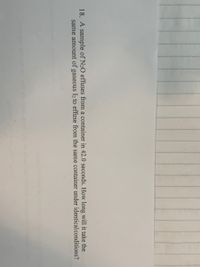
Chemistry
10th Edition
ISBN: 9781305957404
Author: Steven S. Zumdahl, Susan A. Zumdahl, Donald J. DeCoste
Publisher: Cengage Learning
expand_more
expand_more
format_list_bulleted
Concept explainers
Question

Transcribed Image Text:**Transcription for Educational Website**
**Question 18:**
A sample of N₂O effuses from a container in 42.9 seconds. How long will it take the same amount of gaseous I₂ to effuse from the same container under identical conditions?
**Explanation:**
This question involves the concept of effusion, which is explained by Graham's law. Graham's law states that the rate of effusion of a gas is inversely proportional to the square root of its molar mass. In this problem, you are asked to compare the effusion times for nitrous oxide (N₂O) and iodine gas (I₂) under identical conditions. You can use Graham's law to determine the time it will take I₂ to effuse.
Expert Solution
This question has been solved!
Explore an expertly crafted, step-by-step solution for a thorough understanding of key concepts.
This is a popular solution
Trending nowThis is a popular solution!
Step by stepSolved in 2 steps

Knowledge Booster
Learn more about
Need a deep-dive on the concept behind this application? Look no further. Learn more about this topic, chemistry and related others by exploring similar questions and additional content below.Similar questions
- 9.26 mol of argon gas is admitted to an evacuated 4,546.84 cm3 container at 38.34oC. The gas then undergoes an isochoric heating to a temperature of 293.66oC. What is the final pressure?arrow_forwardIf it takes 12.0 hours for a volume of nitrogen, N2 to effuse through pores in a balloon, how long would it take for the same volume of helium, He, to effuse under the same conditions?arrow_forwardWhat's the definition of rate of effusion and write Graham's Law equation with respect to his findings relating rate and molar mass, and compare the relative rates of effusion for two different gasss to their molecular masses.arrow_forward
- 24barrow_forward6. On a certain day a laboratory barometer indicates that the atmospheric pressure is 786.2 torr. A sample of gas is placed in a flask attached to an open-end mercury manometer, and a meter stick is used to measure the height of the mercury in the two arms of the U tube. The height of the mercury in the open-end arm is 80.4 mm, and the height in the arm in contact with the gas in the flask is 123.5 mm. What is the pressure of the gas in the flask (a) in atmospheres, (b) in kilopascals?arrow_forwardAt what pressure does the mean free path of Argon at 298 K become comparable to the size of a 1.000 L (spherical) vessel that contains the gas? Take the diameter of argon to be about 0.339 nm.arrow_forward
- A sample of an ideal gas at 1.00 bar and a volume of 1.91 L1.91 L was placed in a weighted balloon and dropped into the ocean. As the sample descended, the water pressure compressed the balloon and reduced its volume. When the pressure had increased to 60.0 bar,60.0 bar, what was the volume of the sample? Assume that the temperature was held constant.arrow_forwardA particular balloon can be stretched to a maximum surface area of 1257 cm². The balloon is filled with 3.2 L of helium gas at a pressure of 759 torr and a temperature of 310 K. The balloon is then allowed to rise in the atmosphere. Assume an atmospheric temperature of 273 K and determine at what pressure the balloon will burst. (Assume the balloon to be in the shape of a sphere.) Express your answer using two significant figures. 15] ΑΣΦ P = 0.22 Submit Previous Answers Request Answer ? X Incorrect; Try Again; 5 attempts remaining atmarrow_forwardWhen limestone (solid CaCO3) is heated, it decomposes into lime (solid CaO) and carbon dioxide gas. This is an extremely useful industrial process of great antiquity, because powdered lime mixed with water is the basis for mortar and concrete - the lime absorbs CO₂ from the air and turns back into hard, durable limestone. Suppose a limekiln of volume 800. L is pressurized with carbon dioxide gas to 14.9 atm, and heated to 960.0 °C. When the amount of CO, has stopped changing, it is found that 3.96 kg of CaCO, have appeared. Calculate the pressure equilibrium constant K, this experiment suggests for the equilibrium between CaCO3 and CaO at 960.0 °C. Round your answer to 2 significant digits. Note for advanced students: it's possible there was some error in this experiment, and the value it suggests for K, does not match the accepted value. K = 3.07 Parrow_forward
arrow_back_ios
arrow_forward_ios
Recommended textbooks for you
 ChemistryChemistryISBN:9781305957404Author:Steven S. Zumdahl, Susan A. Zumdahl, Donald J. DeCostePublisher:Cengage Learning
ChemistryChemistryISBN:9781305957404Author:Steven S. Zumdahl, Susan A. Zumdahl, Donald J. DeCostePublisher:Cengage Learning ChemistryChemistryISBN:9781259911156Author:Raymond Chang Dr., Jason Overby ProfessorPublisher:McGraw-Hill Education
ChemistryChemistryISBN:9781259911156Author:Raymond Chang Dr., Jason Overby ProfessorPublisher:McGraw-Hill Education Principles of Instrumental AnalysisChemistryISBN:9781305577213Author:Douglas A. Skoog, F. James Holler, Stanley R. CrouchPublisher:Cengage Learning
Principles of Instrumental AnalysisChemistryISBN:9781305577213Author:Douglas A. Skoog, F. James Holler, Stanley R. CrouchPublisher:Cengage Learning Organic ChemistryChemistryISBN:9780078021558Author:Janice Gorzynski Smith Dr.Publisher:McGraw-Hill Education
Organic ChemistryChemistryISBN:9780078021558Author:Janice Gorzynski Smith Dr.Publisher:McGraw-Hill Education Chemistry: Principles and ReactionsChemistryISBN:9781305079373Author:William L. Masterton, Cecile N. HurleyPublisher:Cengage Learning
Chemistry: Principles and ReactionsChemistryISBN:9781305079373Author:William L. Masterton, Cecile N. HurleyPublisher:Cengage Learning Elementary Principles of Chemical Processes, Bind...ChemistryISBN:9781118431221Author:Richard M. Felder, Ronald W. Rousseau, Lisa G. BullardPublisher:WILEY
Elementary Principles of Chemical Processes, Bind...ChemistryISBN:9781118431221Author:Richard M. Felder, Ronald W. Rousseau, Lisa G. BullardPublisher:WILEY

Chemistry
Chemistry
ISBN:9781305957404
Author:Steven S. Zumdahl, Susan A. Zumdahl, Donald J. DeCoste
Publisher:Cengage Learning

Chemistry
Chemistry
ISBN:9781259911156
Author:Raymond Chang Dr., Jason Overby Professor
Publisher:McGraw-Hill Education

Principles of Instrumental Analysis
Chemistry
ISBN:9781305577213
Author:Douglas A. Skoog, F. James Holler, Stanley R. Crouch
Publisher:Cengage Learning

Organic Chemistry
Chemistry
ISBN:9780078021558
Author:Janice Gorzynski Smith Dr.
Publisher:McGraw-Hill Education

Chemistry: Principles and Reactions
Chemistry
ISBN:9781305079373
Author:William L. Masterton, Cecile N. Hurley
Publisher:Cengage Learning

Elementary Principles of Chemical Processes, Bind...
Chemistry
ISBN:9781118431221
Author:Richard M. Felder, Ronald W. Rousseau, Lisa G. Bullard
Publisher:WILEY